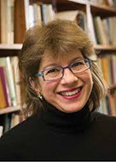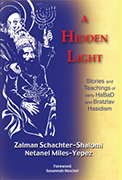
Susannah Heschel
Foreword
A Hidden Light: Stories & Teachings of Early Habad & Bratzlav Hasidism
by Rabbi Zalman Schachter-Shalomi and Netanel Miles-Yepez.
Judaism was born in mobility—what Heine call a “portable fatherland.” Indeed, central to Jewish history is mobility. Jews began with our journey from Egypt to the land of Israel, from Israel to Babylonia, to the Mediterranean basin, Europe, China, even Africa and India, and the Americas, and back again to Israel. From each journey and from each foreign location, we enriched our culture—our languages, Torah interpretations, foods, and even our halakhah.
Our journeys were not only outward, but also inward. And Hasidism has a central concern with that inward journey of each Jew. Commenting on God’s command to Abraham, “Lekh lekha,” Levi Yitzhak of Berditchev, author of the wonderful commentary, Kedushat Levi, notes that the repetition in the phrase indicates that God wanted Abraham not simply to go forward on the physical plane, but to go forward on the inward plane—indeed, to move inward more deeply. Hasidism, as Reb Zalman and Netanel write, “involves an astounding heavenly journey with the inner teacher.”
Hasidism, too, was on a journey from the outset, moving from special centers, such as Mezhbizh and Sadegora, to villages and cities throughout Eastern Europe. Rebbes would study with one tzaddik, then move to learn from another, and then settle in a place where they were most needed. Reb Zalman and Netanel note that Reb Nahman of Bratzlav settled in Uman because it was “a city of lost souls.” At times, massive, dangerous journeys were undertaken, such as Nahman’s travels to Ottoman-controlled Eretz Yisra’el (1798-1799). Hasidic Rebbes recognized this: going to Israel was for Nahman a spiritual ascent of his soul, an expedition of his religious life. Nahman himself said, “I saw that I would have to die in Istanbul, but the humiliation and insults I suffered saved me. One must overcome many barriers to approach the Holy Land.” And Hasidim would often travel great distances to be at the tish of their Rebbe, or to have the privilege of a private meeting with the Rebbe—a meeting that was also a journey, elevating their souls to a higher plane.
Hasidism calls our attention to the mobility that takes place throughout the life of an individual Jew: an inner journey. Hasidic teachings, texts, and stories come as guides to that journey. In this beautiful book, Reb Zalman Schachter-Shalomi and Netanel Miles-Yepez recreate the world of early Hasidism, and through their retelling of the journeys of the Rebbes, they bring us to the spiritual landscape of Ukraine, letting us travel from the court of one Rebbe to another, tasting the different traditions and personalities.
For decades, Reb Zalman, too, has been on a journey. One of the central tasks of a Hasidic Rebbe is to practice yeridah, ‘descent,’ for the sake of lifting up lost souls, and that has been one of the great missions of Reb Zalman. For the post-war generations asking, who is there to give us back our souls, Reb Zalman came to us. Bringing with him his own extraordinary journeys through Hasidism, Lubavitch, Sufism, Native American traditions, and much more, he has taught us, inspired us, and lifted up our souls to a higher level. Such work can only be accomplished through a profound empathy with others and a recognition that suffering, whether physical or the depression of spirit, has significance and profound value in the journey of the inner life. Cultivating such empathy and understanding is the great task of the Rebbe. Someone once asked the Apter Rav, Abraham Joshua Heschel of Apt, known as the “Ohev Yisra’el,” the lover of the Jewish people, how he could remember the names and the troubles of each of the dozens of people who came to him daily, pouring out their troubles and asking him to pray for them. He explained, “When someone pours out their troubles to me, their pain enters my heart and makes a scar. And when I come to pray, I open my heart to God and I say, look at all these scars.” Imagine what it is to be such a person; imagine, too, what a gift it is to have a Rebbe who will listen in this way.
But listening with such empathy requires that a Rebbe experience first-hand what other people are suffering. Reb Nahum of Chernobyl, author of the Meor Enayim, was famous for pidyon shevuyim, redemption of Jews who had been taken captive by Gentiles. Russian authorities grew suspicious of him at one point and put him in prison in Zhitomir, Ukraine. One day an elderly woman appeared at the door of his prison cell and spoke to him: “Ha-shem told Avraham Avinu, lekh lekha, go and set out on the road. Since Avraham Avinu excelled in the mitzvah of hakhnasat or'im, hospitality toward guests, ha-Shem wanted him to be able to fulfill this great mitzvah b’shleimut, on the highest possible level of perfection. Therefore ha-Shem told Avraham Avinu to travel, in order to know what it is like to be a guest himself.” From this, Reb Nahum explained, “I understood that the reason I was imprisoned was because I am active in the mitzvah of pidyon shevuyim. Without knowing what it is like to sit in prison myself, it would not be possible for me to do this mitzvah on the highest level. Now that I know the reason for my being here, I am confident that I will be released shortly.” To redeem others from prison not as a business transaction but as a true mitzvah meant that Reb Nahum had to personally come to experience the horrors of sitting in a jail cell. Only then was his redemption of others undertaken with a full heart.
Reb Zalman came to us in America, to a post-war world that found itself suddenly bereft of the richness and vitality of the East European Hasidic life that had been destroyed, and he, too, engaged in a yeridah. He left the self-enclosed world of Lubavitcher Hasidism and joined us in our secular, bewildered, alienated Jewish communities that had lost a connection to the roots of its soul in Europe. Immersing himself as an act of yeridah, Reb Zalman also empathized with what it is like to live a life of alienation, and he sought our redemption from an intellectual captivity and helped restore to us the Jewish heritage of our souls.
This is a book to be read not only with the mind and the heart, but also with the imagination. Think as you read: what would you say if you had the great opportunity to meet with Nahman of Bratzlav, or with the Alter Rebbe? What problem of your soul would you reveal, what spiritual nourishment would you hope to receive? How would you, too, be lifted up and redeemed?
We may not be living the lives of Hasidim in nineteenth-century Ukraine, but our lives have been inspired and transformed by Reb Zalman. For his work as Rebbe, teacher, and writer, we are deeply grateful.
Susannah Heschel
Eli Black Professor of Jewish Studies
Dartmouth College
Gaon Books
P.O. Box 23924
Santa Fe, NM 87502
505.920.7771
gaonbooks@gmail.com
Gaon Books
Excellence in Publishing
All images and texts in this website are under copyright.
To use materials please contact Gaon Books

